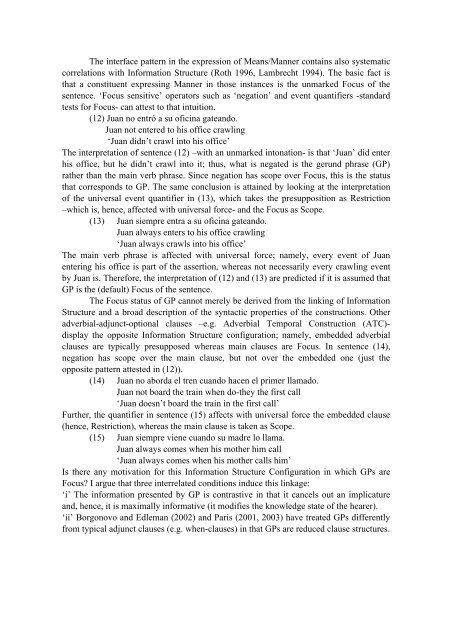SemPrag03.Progr.pdf - Institut für Linguistik/Germanistik - Universität ...
SemPrag03.Progr.pdf - Institut für Linguistik/Germanistik - Universität ...
SemPrag03.Progr.pdf - Institut für Linguistik/Germanistik - Universität ...
Create successful ePaper yourself
Turn your PDF publications into a flip-book with our unique Google optimized e-Paper software.
The interface pattern in the expression of Means/Manner contains also systematic<br />
correlations with Information Structure (Roth 1996, Lambrecht 1994). The basic fact is<br />
that a constituent expressing Manner in those instances is the unmarked Focus of the<br />
sentence. ‘Focus sensitive’ operators such as ‘negation’ and event quantifiers -standard<br />
tests for Focus- can attest to that intuition.<br />
(12) Juan no entró a su oficina gateando.<br />
Juan not entered to his office crawling<br />
‘Juan didn’t crawl into his office’<br />
The interpretation of sentence (12) –with an unmarked intonation- is that ‘Juan’ did enter<br />
his office, but he didn’t crawl into it; thus, what is negated is the gerund phrase (GP)<br />
rather than the main verb phrase. Since negation has scope over Focus, this is the status<br />
that corresponds to GP. The same conclusion is attained by looking at the interpretation<br />
of the universal event quantifier in (13), which takes the presupposition as Restriction<br />
–which is, hence, affected with universal force- and the Focus as Scope.<br />
(13) Juan siempre entra a su oficina gateando.<br />
Juan always enters to his office crawling<br />
‘Juan always crawls into his office’<br />
The main verb phrase is affected with universal force; namely, every event of Juan<br />
entering his office is part of the assertion, whereas not necessarily every crawling event<br />
by Juan is. Therefore, the interpretation of (12) and (13) are predicted if it is assumed that<br />
GP is the (default) Focus of the sentence.<br />
The Focus status of GP cannot merely be derived from the linking of Information<br />
Structure and a broad description of the syntactic properties of the constructions. Other<br />
adverbial-adjunct-optional clauses –e.g. Adverbial Temporal Construction (ATC)-<br />
display the opposite Information Structure configuration; namely, embedded adverbial<br />
clauses are typically presupposed whereas main clauses are Focus. In sentence (14),<br />
negation has scope over the main clause, but not over the embedded one (just the<br />
opposite pattern attested in (12)).<br />
(14) Juan no aborda el tren cuando hacen el primer llamado.<br />
Juan not board the train when do-they the first call<br />
‘Juan doesn’t board the train in the first call’<br />
Further, the quantifier in sentence (15) affects with universal force the embedded clause<br />
(hence, Restriction), whereas the main clause is taken as Scope.<br />
(15) Juan siempre viene cuando su madre lo llama.<br />
Juan always comes when his mother him call<br />
‘Juan always comes when his mother calls him’<br />
Is there any motivation for this Information Structure Configuration in which GPs are<br />
Focus? I argue that three interrelated conditions induce this linkage:<br />
‘i’ The information presented by GP is contrastive in that it cancels out an implicature<br />
and, hence, it is maximally informative (it modifies the knowledge state of the hearer).<br />
‘ii’ Borgonovo and Edleman (2002) and Paris (2001, 2003) have treated GPs differently<br />
from typical adjunct clauses (e.g. when-clauses) in that GPs are reduced clause structures.

















